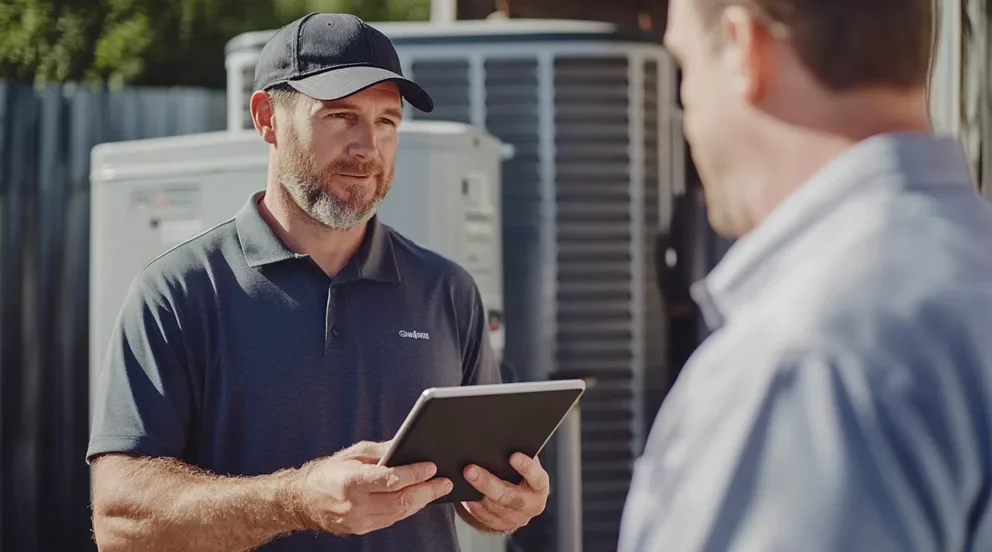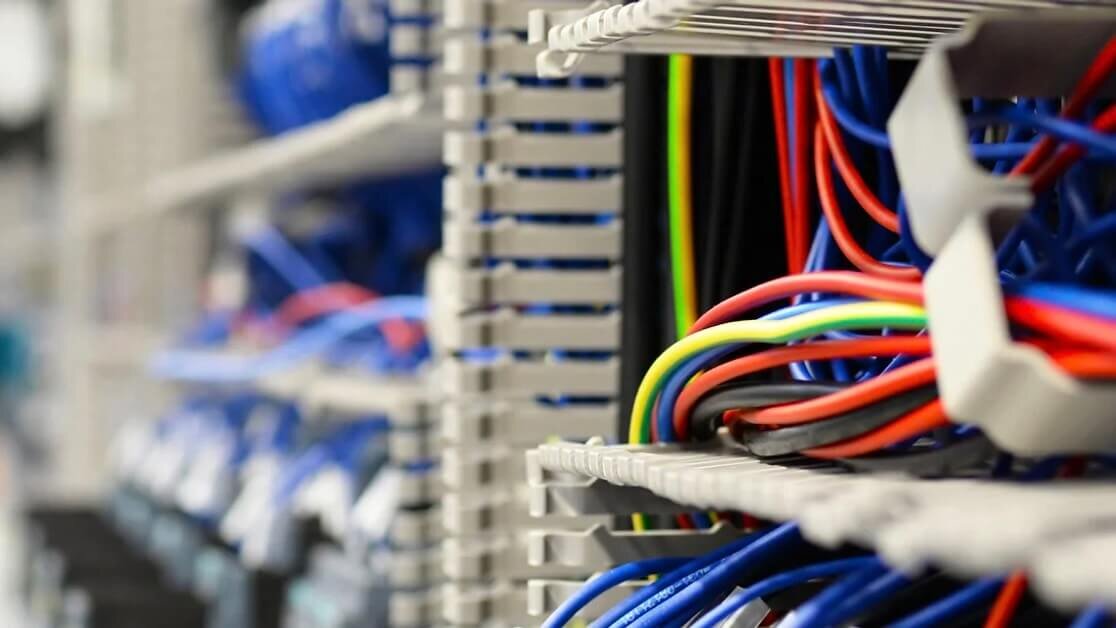Paper invoices and clunky spreadsheets slow you down. Effective Invoicing software for HVAC contractors puts everything in one place—billing, payments, and client info—so you can focus on the work that actually matters. Whether you’re chasing late payments or taking on multiple service calls, the right invoicing tool keeps your operation on track and your cash flow steady.
Here’s a guide to finding the best software for your business.
- Choosing the right HVAC invoice software for your needs
- 5 key features to look for in HVAC invoicing software
- Best for commercial contractors: BuildOps
- Best for residential: Jobber
- Best for general contractors: Tradify
- Other notable HVAC invoicing software providers
- 5 benefits of using HVAC invoicing software
- 5 important HVAC invoicing software FAQs answered
Invoicing software should make billing easier, help you get paid faster, and reduce admin headaches. Here’s what to focus on when choosing a tool.
Choosing the right HVAC invoice software for your needs
Your invoicing software should make your life easier. It needs to handle the specific demands of your business—like managing service calls, tracking payments, and staying accurate under pressure. Picking the right invoicing software starts with understanding the unique needs of your team. From managing service calls to tracking payments, these are the key factors your team should prioritize to ensure smoother operations and fewer headaches.
- Ease of use - Is the software intuitive enough for your team to use without extra training? Tools designed specifically for contractors, not office workers, are your best bet. Look for features that make creating, sending, and tracking invoices quick and hassle-free, especially in a busy HVAC environment.
- Cost to value - Does the price make sense for what you’re getting? It should save time by automating routine tasks, minimize invoicing errors, and improve cash flow—without overpaying for features you don’t need.
- Compatibility and integration - Will the software work with your existing systems, like scheduling platforms or accounting tools? A seamless connection can save time and prevent headaches down the road.
- System support and security - Does the provider offer real-time help when issues arise? On top of that, ensure the software protects sensitive data with encryption and complies with security standards.
- Features - Can the software handle all your invoicing needs? From automating reminders to tracking payments and creating branded invoices, it should make invoicing faster, easier, and error-free. The right features don’t just speed things up—they eliminate unnecessary admin work altogether.
Some tools are designed with contractors in mind, offering key functionalities that optimizes invoicing and make your life easier. Let’s take a closer look at the must-have features to prioritize in your search.
5 key features to look for in HVAC invoicing software
Without slowing you down, the best hvac business invoicing software should offer more ways for you to track payments, generate bills more quickly, and maintain organization. If you’re looking for features that keep your cash flow steady and your team efficient, here’s what to focus on.
1. Create and send invoices
Your invoicing software should make it simple to generate and send invoices, whether from the office or directly on the job site. Look for tools that allow technicians to create invoices in real time, complete with all job details like labor hours, materials, and service descriptions, and that can leverage information you’ve already entered into your project management tool into invoice details automatically.
Why does this matter? Shops that send invoices within the first 10 days of job completion are significantly more likely to get paid faster. Delays—even by a single day—can extend your payment cycle by weeks. An all-in-one field service management tool with an invoicing solution like BuildOps makes this process seamless by enabling invoices to be sent before your team even leaves the job site.
2. Manage contracts and suppliers
The best invoicing software doesn’t stop at generating invoices, but helps you organize all customer and supplier data in one place. This means you can quickly access customer records, track payment history, and even segment clients based on their payment behavior.
For example, BuildOps allows contractors to track overdue accounts while still managing reliable customers with on-time payment records. These tools give you a clear picture of your business relationships and ensure smoother cash flow management. To understand how they could help you more, here are some examples of HVAC invoices.
3. Payment processing
Seamless payment processing is essential for any HVAC invoice platform. Look for HVAC invoicing apps that let techs accept payments on-site. Quality software supports multiple payment methods, including credit cards, ACH transfers, and digital wallets, to ensure convenience for your customers.
Ideally, contractors can collect payments right in the field, reducing the risk of delays and helping improve cash flow.
4. Overdue payment management
Software that can equip contractors with automatic reminders and escalation features to address late payers effectively is key, as delaying follow-ups past 20 days significantly reduces the chances of timely payment.
Look for platforms that help you track overdue invoices, segment customers by payment trends, and enforce penalties like late fees if necessary. These features ensure you still get paid, even when customers fall behind, and can really reduce how much time you spend chasing customers for invoice payments.
5. Automated record-keeping
Invoicing software should simplify record-keeping by automatically storing payment details, invoice records, and customer interactions in a centralized database. All-in-one tools like BuildOps go a step further by connecting these records with other parts of your workflow, like scheduling and reporting. This eliminates manual errors, saves time, and ensures your data is always easy to access when needed
Other valuable features for HVAC service companies
- Integration compatibility - Invoicing software should integrate seamlessly with tools like scheduling, CRMs, and accounting platforms. This keeps your systems in sync and saves time on manual data entry.
- Financial reporting - Generate reports on income, overdue invoices, and payment trends to make informed decisions and keep cash flow healthy.
- Automated accounting - Automatically sync payment data and update financial records, cutting down on manual tasks and ensuring accuracy.
Invoicing software needs vary depending on the type of contractor. Commercial teams require tools to handle large projects and complex workflows, while residential and general contractors prioritize simplicity and flexibility. Let’s break down the best options for each.

Perfect your invoice execution
Check out our Contractor’s Invoicing Toolkit to learn how to nail invoicing.
Best for commercial contractors: BuildOps
BuildOps is designed with commercial contractors in mind, offering a comprehensive suite of tools to streamline invoicing and manage complex workflows. It simplifies billing for larger projects, integrates seamlessly with your operations, and keeps everything from estimates to payments organized in one place.
How pricing works: BuildOps uses a customized pricing model based on your business size and needs. This ensures you’re only paying for the features that directly impact your operations.
Features beyond invoicing:
- Real-time job tracking and scheduling
- Automated payment reminders
- Comprehensive reporting and analytics
What sets it apart for commercial: BuildOps stands out by tailoring its platform specifically to the needs of commercial contractors, offering a highly effective real-time tracking, automatic payment reminders, and seamless integration with existing workflows.
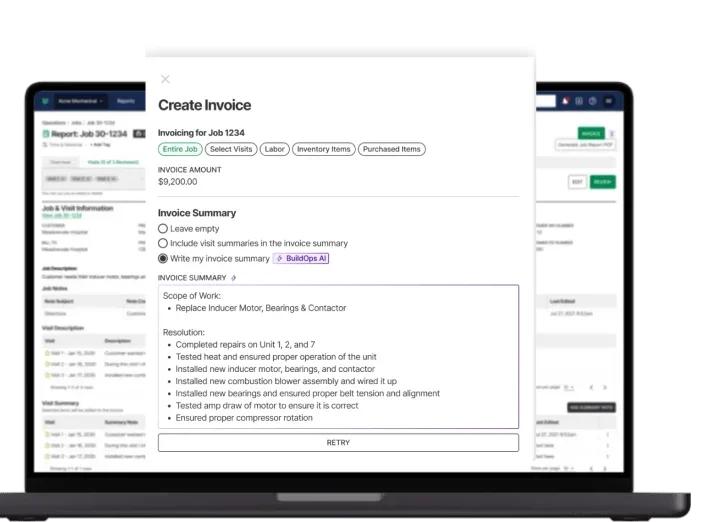
Find out how BuildOps can help
BuildOps helps you effortlessly conduct invoicing so you stay organized and bill faster.
Best for residential: Jobber
Image Source: Jobber
Jobber is a great fit for residential contractors, offering straightforward tools to manage invoicing, scheduling, and client communication. Its clean interface makes it simple for small teams to create and send invoices quickly.
How Pricing Works: Jobber offers tiered pricing plans, allowing you to choose the package that aligns best with your business size and needs.
Features Beyond Invoicing:
- Built-in scheduling and dispatching tools
- CRM features to manage client relationships
- Mobile app for on-the-go access
What Sets it Apart for Residential: Jobber is built with residential contractors in mind, focusing on ease of use and streamlined workflows for small teams.
Learn how to simplify operations for residential contractors with Jobber’s invoicing tools.
Best for general contractors: Tradify
Image Source: Tradify
Tradify is designed for general contractors who need a flexible invoicing platform that works across a variety of project types. With its simple layout, you can easily create quotes, track time, and manage invoices all in one place.
How Pricing Works: Tradify offers three pricing tiers tailored to different needs, giving contractors the flexibility to choose the plan that best suits their business.
Features Beyond Invoicing:
- Quick and accurate quote creation
- Real-time time tracking and task management
- A mobile app for field and office synchronization
What Sets it Apart for General Contractors: Tradify excels at simplifying the management of diverse projects, helping general contractors track progress, assign tasks, and manage timelines effortlessly.
Discover how to support general contractors by visiting Tradify’s invoicing platform.
Other notable HVAC invoicing software providers
While many tools offer invoicing solutions, some stand out for their focus on specific features that cater to contractors’ unique needs, and work well for companies working in HVAC. Here are three more notable options worth considering:
Autodesk Build
Image Source: Autodesk Build
Autodesk Build is a robust tool designed for contractors who manage complex projects and require advanced dispatch capabilities. It integrates seamlessly with broader project management workflows, making it a solid choice for larger-scale operations.
How pricing works: Autodesk Build offers tiered pricing based on the scope of features and users, giving businesses flexibility to choose what suits their project size.
Features beyond invoicing:
- Advanced dispatching tools for team coordination
- Comprehensive project management features
- Real-time data tracking and collaboration
What sets it apart for dispatch: Autodesk Build’s strength lies in its dispatching tools, which ensure that teams and resources are allocated efficiently across multiple projects.
Learn more about Autodesk Build’s invoicing functionality.
Workiz
Image Source: Workiz
Workiz focuses on simplifying field service management for small to medium-sized businesses. Its platform provides easy-to-use tools for managing invoices, scheduling, and team communications.
How pricing works: Workiz offers four pricing tiers— Lite, Standard, Pro, and Ultimate—tailored to different business needs and team sizes.
Features beyond invoicing:
- Scheduling and route optimization tools
- Integrated call tracking and management
- Payment processing capabilities
What sets it apart for field service management: Workiz stands out with its all-in-one platform that combines invoicing with tools for field service efficiency, making it ideal for teams on the move.
Find out how Workiz field service invoicing works.
Buildertrend
Image Source: Buildertrend
BuilderTrend is a popular choice for contractors who rely heavily on scheduling to manage their projects. It combines invoicing with powerful scheduling tools to keep teams and timelines on track.
How Pricing Works: BuilderTrend uses a subscription model with pricing based on the features and number of projects managed.
Features Beyond Invoicing:
- Comprehensive scheduling and project planning tools
- Client communication and document sharing
- Financial tracking and reporting
What sets it apart for scheduling: BuilderTrend’s intuitive scheduling system keeps project timelines organized and adaptable, ensuring contractors can meet deadlines without missing critical steps.
Learn more about how BuilderTrend’s invoicing functions can help contractors.
5 benefits of using HVAC invoicing software
Choosing the right HVAC invoice software is easier when you understand exactly what it can do for your business. From its core features to industry-specific requirements, knowing the essentials helps you make the best decision.
1. Receiving payments faster
For HVAC businesses, quicker payments mean better cash flow to cover materials, payroll, and operational costs. HVAC-specific invoicing tools enable technicians to send invoices immediately after a job and let customers pay on the spot. This eliminates delays and helps you get paid sooner.
2. Streamlining the invoicing process
Handling multiple service calls, customer requests, and last-minute changes is part of the job. HVAC invoice software simplifies the entire process by allowing you to create and send invoices directly from the field. This means fewer errors and faster billing, even when you’re managing a packed schedule.
3. Automated payment reminders
In the HVAC world, it’s not uncommon to deal with late-paying clients. Automated reminders ensure that customers receive follow-ups on outstanding invoices without your team having to manually chase them. These tools help reduce overdue payments and keep your revenue flowing smoothly.
4. Improved financial visibility
Tracking your business’s financial health is critical for HVAC contractors juggling multiple projects and clients. HVAC invoice software provides detailed insights into overdue invoices, payment trends, and cash flow—so you can make smarter decisions and be more efficient.
5. Reduced paperwork
With HVAC invoicing software, there’s no need to sift through piles of paper to track job details or payments. Digital records store everything from service descriptions to payment confirmations, keeping your operations organized and your data secure—all in one place.
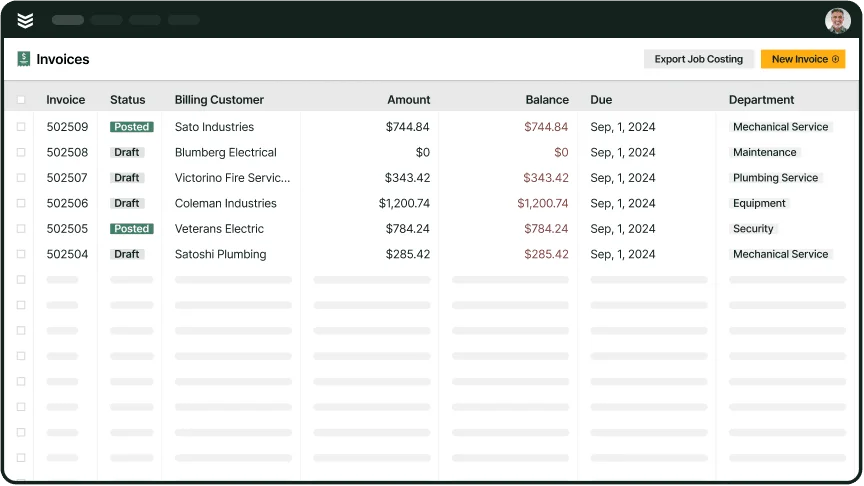
Speed up invoicing and payments
We know what companies need to streamline invoicing and optimize cash flow.
5 important HVAC invoicing software FAQs answered
Still have questions about HVAC invoice software? You’re not alone. Whether you’re new to using digital tools or looking to upgrade, here are the answers to some of the most frequently asked questions to help you navigate your options.
1. What is HVAC invoicing software?
HVAC invoice software is a digital tool designed to simplify billing and payment processes for HVAC businesses. It helps contractors create, send, and track invoices while integrating with other operational tools like scheduling, dispatching, project management, and CRM systems.
2. How does HVAC invoicing software work?
HVAC invoice software works by digitizing the invoicing process. Technicians can generate invoices in the field, add job details like labor and materials, and send them to customers via email or mobile apps. Payments are tracked in real-time, and overdue reminders are sent automatically.
3. Who needs HVAC invoicing software?
Any HVAC business, from small residential operations to large commercial contractors, can benefit from invoicing software. If you’re managing multiple jobs, chasing overdue payments, or looking to streamline admin tasks, these tools are essential.
4. Are there any restrictions or compliance requirements to be aware of when using HVAC business invoicing software?
Yes, HVAC invoice software may be subject to restrictions based on the region it’s used. Many countries enforce consumer protection laws for billing, and businesses must comply with these rules. Companies should also follow industry-specific regulations and best practices like data encryption and user authentication.
5. What are some best practices to follow when implementing an HVAC invoicing software?
- Choose user-friendly software to ensure easy adoption, and integrate it with existing systems like accounting tools for seamless workflows
- Provide training for staff, customize settings to fit your business needs, and regularly monitor performance to ensure effectiveness
- Customize features to match your business needs
- Regularly monitor and evaluate the software’s performance
- Secure sensitive customer data with encryption and robust access controls
When it comes to HVAC invoicing software, BuildOps stands out by offering a complete suite of features tailored for contractors. While many tools only provide basic functionality, BuildOps goes beyond with real-time invoicing, seamless integrations, and automated workflows—all designed to handle the demands of commercial HVAC businesses.
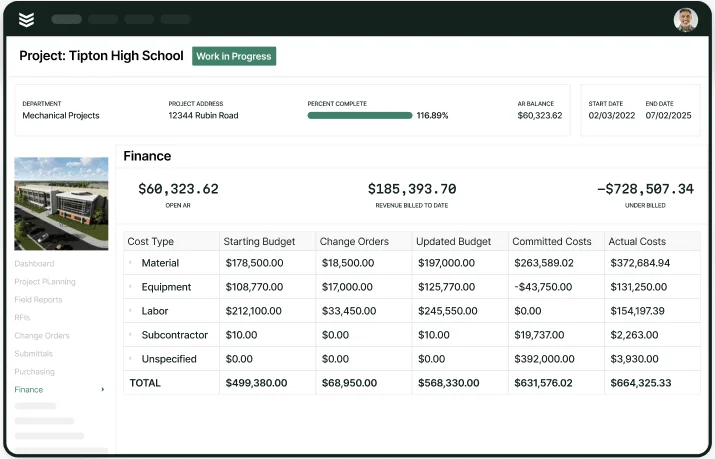
Want to see BuildOps in action?
Built for commercial HVAC contractors, BuildOps helps teams get paid faster.



